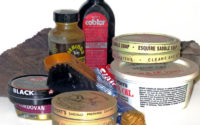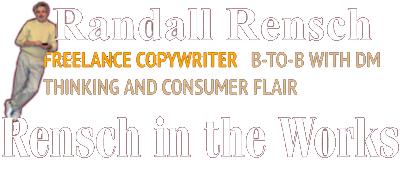I’ve always advocated storytelling. But now that everyone is a “storyteller,” are all these stories all that interesting? Are they even stories?

Since earliest times, humans have told stories at the fireside, sparking imagination.
First off, maybe I should apologize for having joined the “stories” bandwagon on my recently renovated homepage. Me-too-ism is hardly the way to show my stuff as a copywriter. But, although the bandwagon is overcrowded, and it’s a new theme at Rensch.com, it’s absolutely not a new approach for me.
In copywriting for marketing communications, nobody is a bigger fan of storytelling than I — since my writerly beginning. I majored in Journalism, and what do reporters call their writing? Stories.
Also early in my advertising career, I became a devoted follower of David Ogilvy.
Ogilvy was a revolutionary copywriter and agency leader. And a storyteller. He often told full-page advertising tales that paid off headlines like “At 60 miles an hour the loudest noise in this new Rolls-Royce comes from the electric clock.” Ogilvy favored intriguing gimmicks, such as the Man in the Hathaway Shirt. (How did he get that eyepatch, anyway? Ogilvy kept mum about that, even within the ad industry.) Like all great storytellers, he used plain language even when the story is technical: Touring the client’s plant and learning a vat contained stearic acid, he asked, “What’s that?” The answer led to his highly effective product story that survives to this day: “Dove soap is one-quarter cleansing cream.”
Good stories grab and hold interest. They dramatize, explain and convince. They’re memorable. So I’ve advocated storytelling as an excellent copywriting technique for as long as I’ve been writing ad copy.
Now, everyone has picked up on it. That’s good. Except that a lot of them have got it wrong. A weak story, or a pitch misrepresented as a story, does not confer those benefits. It fails to attract. It bores and turns away, or even annoys.
Copy isn’t a story just because you say it is.
It’s not your old photos. Even Facebook is automatically compiling people’s “stories,” no actual storytelling required. How is a random collection a “story”? It’s fun, sweet, or whatever. But unless expertly curated and worked into a theme or progression, it’s an album.
It’s not just an impression, a color combination, or a theme. I can see how it might apply, but again, it’s a stretch. If the decor or a room has a nautical theme, or the whole house has continuity of hues, the designer might call it a story. But it’s no more a story than a musical theme is a song.
It is not a sales pitch. This is the biggest stretch of all. Whether talking about features or benefits, let’s fess up: overt selling is not “storytelling.” A story has a plot, an incident, has built-in personal interest. Most importantly, it stands on its own. There’s nothing wrong with selling a reader or viewer on product qualities and explaining how they benefit the listener, but — even a demonstration is not a story. A story needs all the qualities mentioned above, not just a scenario.
(Here’s a 2014 video by a graphic designer who said that too many people naively bill themselves as “storytellers.” I’ve said it more briefly with less “colorful” language, but it documents how long the theme has raged out of control.)
Gad.
Before revamping my website, I revisited a lot of old emails from clients. I was surprised to realize that storytelling was a thing among them, long before it saturated social media. Several of my clients talked about stories many years ago, using exactly that word. For example, one said he expected me to bring his own story out of him.
So, even though I had drafted my home page copy several years ago, I was already late to the table by the time I posted it. The “story” angle seemed pretty trite. Thus my embarrassment.
But I’ve jumped on the bandwagon anyway, if only to make this point:
It’s important to know the difference.
All sorts of marketers have created blogs and other social media “content” (quotation marks very intentional!) touting them as stories. But not only are most of these companies not telling good stories, they’re not telling stories at all, or are saying the same things.
Story or not, who cares if marketers all say the same thing?
That question itself should speak to you as a marketing pro. “Me too” is seldom the way to capture a market. Yet, more and more companies slavishly (or more, sheepishly) set up their blogs, set content quotas and specifications, filling space, expecting the world to divert to their door. Or, sometimes their objective is to impress the search engines. For a variety of reasons, they just start posting stuff, adding to a din that no reasonable consumer can sift through, let alone absorb.
(It’s a bit like the rich array of TV programming currently available. There are so many great series, but it would be a couple full-time jobs to watch everything. You can’t. And that’s when the programming is good, fresh, original. Unlike so many blogs.)
If you ask an honest expert in contemporary SEO, it doesn’t work that way anyway. A blog storyline might help establish you as an expert in your field, but unless published in the context of a purposeful marketing mix, it’s just another blog, that only robots will visit, SERPs probably won’t feature, and people won’t read …
… because it overlooks one other essential aspect of storytelling:
A story must interest your listener.
From the days of those earliest tribal campfires to whatever you’ve read this week, if a story doesn’t inform or entertain the listener, what’s the point? Does the listener care? Will they stay and listen? Do they even seek out the raconteur with the tribal tales?
Remember: in addition to being a story, it has to be a good story. That’s where Facebook stories, and content factories, and so many other story marketers go wrong.
Furthermore, you have to market it. Everyone needs to know where the storyteller builds his fire, or the location of his hut. And must know when he’s there.
And like the ancient storyteller, leave the moral to the end. Your equivalent of the moral is the Call To Action. Always tell your prospect what they should do next. But while telling the story — just tell the story.
If you’ve got your act together, you don’t have to limit storytelling to a blog. In fact, you might not even need a blog. The venues for storytelling are many:
- Blogs
- Whitepapers
- Case studies
- Checklists
- Crib sheets and tips
- Videos
- Podcasts
- Infographics
- Photos. (Yes, if done right. A photo essay, or a shot with intriguing details within it, or wondering what happened before or after the Decisive Moment.)
If you can give value with any of the above, by all means do, whether it qualifies as a “story” or not. But, if you’re able to craft one, do. A good story is just as interesting, illustrative and valuable to communication as ever. That’s why I hopped on the bandwagon.
Don’t set an artificial schedule or make impossible demands of yourself. Publish whenever you have a good yarn to spin. Relatively infrequently posted material might even invite more frequent visits, if it is satisfying. (See “Intermittent Reinforcement.”)
As long as you don’t start with, “Here is a story.” Just tell it. Make it worth telling. And worth hearing.
Make it a good one.
Related Posts

Homebased workers: Plan to master change

What would you like to know about?

So … Stop that!
About The Author
Randy Rensch
Randall (Randy) Rensch is a senior-level advertising copywriter who worked on-staff for several advertising agencies prior to becoming a full-time freelancer. Nowadays, freelance copywriters abound, but back when Randy turned to freelancing, he had to explain to many prospective clients that he was not between jobs, that he had really hung his shingle as an independent copywriter. Over the years, he has expanded the range of his experience to match the times, particularly in business-to-business marketplaces. He brings his imagination, analysis and results-oriented viewpoint to a wide variety of products and services. Based in New York City, he serves ad agencies, web developers and companies primarily in North America and Europe. Randy has maintained a balance between b-to-b and the consumer advertising where his career began. As important as specialization is to successful freelancing (he's heaviest in financial, technical, retail, online, collateral, direct and radio), the synergy resulting from a broad mix is very helpful to him and his clients. Randy's work on the "15-Minute Breakfast" campaign for International House of Pancakes won the American Marketing Association's Effie Award, given for effectiveness. Randy doesn't pursue awards, but has also earned other acknowledgements, and has been quoted in various books and publications on copywriting and the business of freelancing, including Complete Guide to Creating Successful Brochures (Gedney) and Marketing Essentials (Bickers). Randy has written for written for agencies and directly for marketers including IBM, Sony, T. Rowe Price, United Technologies, Citibank, International House of Pancakes, E.G. Smith, Legg Mason, Wunderman, SiteSell, and hundreds of smaller companies and ad agencies — even very small marketers, helping them become as big as they want to be. With this eclectic background, Randy continues to apply his skills to many kinds of business and consumer products and services, but he specializes in business-to-business, consumer and business financial, technological products and services, and retail (including online stores). He has also had some experience with medical products and services. Randy began his career as a staff copywriter at a radio station in the New York City market (a position he also held for awhile in local television.) Lately, in association with Edge Studio, a commercial recording studio and training facility, he has added narration and non-marketing articles to his repertoire. For samples and insights into Randy's work and the nature of advertising, visit www.rensch.com.
